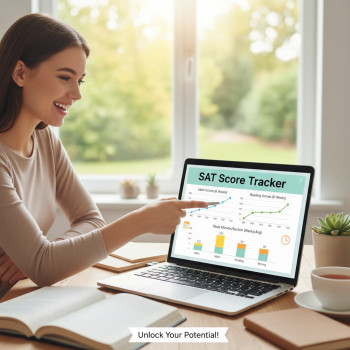Introduction: The SAT in the Ivy League Conversation
If you’re a student dreaming of an Ivy League campus — or a parent navigating the dizzying college admissions maze — the SAT often feels like a bright, shiny, high-stakes object in the middle of the room. Over the last few years the landscape changed: some schools went test-optional; the SAT became fully digital; admissions committees shifted priorities. But the question remains: how do Ivy League colleges view SAT scores today, and what should you actually do about it?
This post unpacks the reality in clear, practical terms. You’ll get a sense of how elite colleges use SAT scores, when scores matter most, how to interpret your score in context, and concrete strategies you can apply in the months leading to application season. I’ll also point out where targeted, personalized help — like Sparkl’s 1-on-1 tutoring and tailored study plans — fits naturally into a competitive admissions strategy.

What Ivy League Admissions Offices Are Really Looking For
Admission to an Ivy League school is holistic. That’s the most important phrase to keep front and center. While SAT scores are a measurable factor, they’re one thread in a tapestry that includes coursework, grades, teacher recommendations, extracurricular impact, essays, demonstrated interest (where relevant), and life context.
Here’s how SAT scores tend to function in that holistic review:
- A screening and contextual signal: Scores provide a common yardstick when applicants come from wildly different high schools and curricula. They help admissions officers compare academic preparation across applicants.
- Scholarship and merit cues: In some cases, strong SAT scores can open doors to merit scholarships or special programs.
- An academic fit indicator: For highly quantitative majors (engineering, economics, computer science), admissions teams pay more attention to the math-related portions as one of several indicators that a student can handle the rigor.
- Not a single gate: Lower-than-average SAT scores don’t automatically close the door if the rest of the application is outstanding and shows upward trajectory, unique achievement, or exceptional context.
Important nuance: Test-optional doesn’t mean test-irrelevant
Many Ivy League schools experimented with test-optional policies recently. Test-optional means you don’t have to submit scores to apply — but if you do, your scores will be considered. For students with strong scores, submitting them can strengthen an application; for students whose strengths lie elsewhere (stellar portfolios, unique life experiences, exceptional grade trends), opting out may be reasonable. The choice is strategic, not automatic.
How to Interpret Your SAT Score in an Ivy Context
Raw numbers (like a 1500 or 1560) are easy to fixate on, but context matters. Below are the practical ways admissions officers put scores in context.
- Percentiles and national context: Admissions teams know how challenging it is to score in the top percentiles. They consider percentile rank alongside GPA and course difficulty.
- School and opportunity context: A 1400 from a small rural school with fewer AP offerings can be more impressive than the same score from a well-resourced prep school. Many Ivy admissions officers assess what opportunities a student had access to and how they maximized them.
- Subject alignment: For STEM applicants, a high math section score matters more. For humanities applicants, a balanced or higher reading/writing score may provide additional credibility.
- Trajectory and improvement: If a student shows consistent improvement — for example, a test score that rose significantly after focused preparation — that upward trend can be persuasive evidence of growth and resilience.
Practical example: Two applicants with the same score
Imagine two students both submit a 1520. One took AP Calculus and led a research team at a community lab; the other comes from a small school with limited math options but is the first in family to aim for college. Admissions reviewers will read other parts of the application to understand which student would thrive academically and which story adds the most value to the incoming class mix. The identical numeric score doesn’t yield identical conclusions.
When Submitting SAT Scores Helps — and When It Doesn’t
Deciding whether to submit scores is strategic. Here’s a simple decision checklist to help students and parents weigh the choice.
| Situation | Consider Submitting Scores If | Consider Opting Out If |
|---|---|---|
| Strong academic record with high GPA and rigorous courses | Your SAT is at or above the middle 50% for the target Ivies; submitting reinforces academic strength. | If score is well below middle 50% and other parts of application are exceptionally strong, you might not need it. |
| Nontraditional background or fewer AP/IB offerings | Submit if score shows academic readiness despite limited opportunities. | Opt out if the score is low and your essays/recommendations tell a compelling story. |
| Applying to quantitative majors | Submit if Math section score is strong. | Opt out only if you have other quant evidence (competitions, research, coursework). |
Using the digital SAT strategically
The SAT’s digital format changes pacing and interface. Students who are comfortable with on-screen reading and digital calculators often perform better. If you took practice digital SATs and your scores improved, that’s a good sign you should submit. If you only took paper tests and score variances are large, you might want to take one official digital test under full-timed conditions before deciding.
What Ivy Admissions Officers Value Beyond the Score
Here’s the short list of qualities that often outweigh a single test result:
- Curiosity and intellectual engagement: Evidence that a student pursues deep interests — research projects, independent study, advanced coursework — has huge weight.
- Impact and leadership: Leadership that creates tangible change (starting an organization, leading community programs, demonstrable results) matters more than titles.
- Authentic voice in essays: Original, reflective essays that reveal decision-making, failure, and growth stand out.
- Contextualized recommendations: Teachers who can contextualize achievement within school constraints add credibility.
In short: strong SAT scores + a rich, coherent application is the sweet spot.

How Much Does an Extra 30–50 Points Really Matter?
It depends. Near the margins — where applicants are similarly qualified — those extra points can nudge a decision. But on a broad scale, admissions officers are looking for reasons to admit students, not just filter them. If your application is edged out by a tiny difference in score, that means the file was competitive — and that’s not a failure; it signals where targeted improvement or a stronger supplemental piece the following year could matter.
Also remember: test scores can affect scholarship decisions, honors program placement, and departmental admissions, so a modest uptick can pay off beyond simple admission outcomes.
Preparing Strategically: Study Plans That Work
Preparation isn’t just about hours logged; it’s about how you spend those hours. Here’s a practical, phased approach you can use in the 6–9 months before test day.
- Phase 1 — Diagnostic and foundation (Weeks 1–4):
- Take a full-length, timed digital practice test to identify strengths and weaknesses.
- Set a realistic target score based on your dream school’s middle 50% and the major you plan to study.
- Phase 2 — Focused skill work (Months 2–4):
- Design targeted practice sessions for the weaker areas (e.g., advanced algebra, command of evidence, data interpretation).
- Use official practice questions and realistic digital practice tests to build familiarity.
- Phase 3 — Strategy and timing (Months 5–6):
- Work on pacing with timed sections, learn which problem types to skip and return to, and refine calculator strategy.
- Polish endurance with full-test simulations under testing rules.
- Phase 4 — Final polishing (Last 4–6 weeks):
- Do light practice, focus on weak-but-fixable skills, and prioritize sleep and stress-management in the last two weeks.
Where personalized tutoring helps most
General study plans help many students, but individualized tuition accelerates improvement for a few reasons:
- 1-on-1 guidance targets the handful of gaps that cost the most points.
- Tailored study plans keep effort efficient, focusing on high-leverage skills rather than generic practice.
- Expert tutors (and smart platforms) provide immediate, actionable feedback and accountability.
Programs like Sparkl’s personalized tutoring can be especially effective when time is tight. Sparkl combines expert tutors, tailored study plans, and AI-driven insights to identify which types of problems a student misses most and how to close those gaps quickly — all in a human-first tutoring environment. That blend of personal attention and data-driven strategy is a practical advantage when you’re aiming for competitive score gains.
How to Use Scores in Applications (and Score Choice Thoughts)
Most colleges allow you to choose which SAT scores to send (Score Choice). If you have multiple test dates, use Score Choice thoughtfully:
- Send the highest single test that reflects your current ability — not an outlier (exceptionally high or low) unless you can explain it.
- If your scores improved over time, sending the most recent and highest score tends to present the strongest case.
- For majors that value specific skills, emphasize the relevant subscores (e.g., Math for STEM).
Remember: if a college superscores (combines section bests across test dates) and you have a mixed history, learn that school’s policy before choosing which dates to send.
Real-World Context: Stories that Illustrate the Point
Story 1: A student with a 1460 but a dazzling research project in computational biology — accepted. The SAT was solid but not dazzling; the application told a story of genuine intellectual contribution and recommendations that corroborated independence and depth. The score opened the door to be considered; the project carried the application through.
Story 2: A student improved from a 1280 to a 1490 after six months of focused, strategic prep with a tutor. The jump mattered because it placed them within the middle 50% for several top schools, and the improvement narrative (hard work, growth mindset) bolstered essays and interviewer conversations.
These stories show how scores function together with other pieces: sometimes they lead, sometimes they confirm, and sometimes they supplement a larger narrative.
Common Parent and Student Questions — Answered
Q: Should I cancel SAT plans because a school is test-optional?
A: Not automatically. Test-optional means you have a choice. If you’re likely to score within or above a school’s middle 50% — or if your score supports your academic narrative — it can help. If your score is substantially below your school’s middle 50% and you can tell a stronger story without it, you might skip it. Consider retesting or targeted prep if you’re within striking distance of the school’s range.
Q: What if my score is lower than my GPA suggests?
A: That mismatch is a conversation starter, not a dead end. Explain coursework rigor, learning differences, or testing conditions where relevant. If you can, take another test and/or show strong standardized evidence elsewhere (AP, IB, A-levels, or subject-specific achievements).
Q: How should juniors plan their testing schedule?
A: Aim to take at least one official digital SAT by the spring of junior year after several months of preparation. If results are below target, plan a summer/fall retake. Use official practice tools on the same digital platform so you’re comfortable with format and timing.
Final Practical Checklist For Students Aiming at the Ivies
- Take an initial, timed digital practice SAT to set a baseline.
- Set a target score informed by the middle 50% ranges of your target schools and your intended major.
- Create a focused study schedule — quality over quantity — and measure progress with regular timed practice tests.
- Decide whether to submit scores based on how they compare to each school’s expectations and your overall application strength.
- Consider 1-on-1 tutoring if you need strategic gains; personalized programs like Sparkl can help by aligning individualized plans with AI-driven insights and expert coaching.
- Work on essays, recommendations, and experiences concurrently — a strong narrative and meaningful accomplishments often tip decisions more than minor score differences.
Takeaway: The SAT Is Important — but It’s Not Everything
Think of the SAT like a single instrument in a chamber orchestra. It can shine, but it rarely plays the whole symphony. Ivy League admissions look for the full composition: intellectual curiosity, sustained achievement, character, and the potential to contribute to a diverse campus community. A strong SAT score helps your instrument stand out; the rest of your application gives the judges a reason to listen to you closely.
If you’re planning on tackling the SAT this year, make a plan that respects both the test and the rest of your story. Use official digital practice, build skills in a focused, efficient way, and consider personalized help if you need targeted gains. With the right preparation and a thoughtful application, that Ivy League campus might be closer than you think.
Parting encouragement
Admissions is unpredictable and personal — and often more human than we imagine. Focus on what you can control: the clarity of your goals, the quality of your preparation, and the authenticity of your application. When in doubt, ask for help, practice deliberately, and present the best, truest version of yourself.
Good luck — and remember: a single test score will never define your entire future. It’s a tool, and when used well, it can open doors. When used poorly, it can cause anxiety. Approach it deliberately, and use every resource you trust, including personalized tutoring, to give yourself the best shot.














No Comments
Leave a comment Cancel